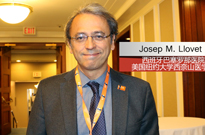
西班牙巴塞罗那医院、美国纽约大学西奈山医学院Josep M. Llovet教授
编者按:肝细胞肝癌(HCC)是世界上导致癌症相关死亡的第二大原因。近年来,有关HCC治疗药物的临床研究以及分子学标志物及相关动物模型的研究,我们取得了哪些重要进展?在刚刚结束的第十届国际肝癌协会(ILCA)年会上,本刊记者有幸邀请到西班牙巴塞罗那医院肝癌研究所(BCLC)、美国纽约大学西奈山医学院Josep M. Llovet教授,针对上述问题进行了深入访谈。现将其内容整理成文,以飨读者。
《国际肝病》:近年来,HCC治疗药物研究方面有怎样的进展?
Llovet教授:个人认为近年来在HCC治疗药物研发领域有两项重大的进展:一是针对索拉非尼(sorafenib)治疗仍出现进展的患者,完成的临床二线治疗药物瑞戈非尼(regorafenib)长达10年的Ⅲ期安慰剂对照试验。此项研究是HCC治疗药物方面的重大突破。该研究结果表明,在索拉非尼治疗后HCC患者病情仍进展,且并无其他治疗选择的情况下,瑞戈非尼将改变当前的治疗原则,也将被纳入新版HCC临床治疗指南。二是关于免疫检查点抑制剂的研究成果,特别是抗PD-1药物nivolumab已显示出较好的临床疗效。例如,一项纳入超过200例HCC患者的大型Ⅱ期试验结果表明,nivolumab的客观缓解率可达到16%,患者的中位生存率约为13~14个月。
Prof. Llovet: I would say that recently, we have had two major developments. One is from this year. For the first time after 10 years of testing drugs in Phase III, and after more than 15 randomized controlled trials, we have a trial that is positive, and that is regorafenib versus placebo in second line (meaning in patients progressing to sorafenib). This trial represents a breakthrough in the management of the disease. It will change the standard of care that currently, in patients progressing to sorafenib, we have no other choice. It will be incorporated in clinical management guidelines for HCC. The second advancement is not yet ready for the incorporation to clinical guidelines, but there are good results with checkpoint inhibitors, particularly with an anti-PD-1 drug nivolumab. It waspresented a large Phase II study with more than 200 patients that reported 16 percent objective response and a median survival of around 13 or 14 months. I think these are the two major advancements.
《国际肝病》:随着我们对HCC分子机制越来越深入的研究,您认为未来有潜力的分子靶点有哪些?相关分子学标志物的研究进展如何?
Llovet教授:是的,过去10年我们已了解了HCC的所有分子分型,以及主要的驱动基因。目前主要的问题是,绝大多数的驱动基因,包括最常见的p53、β-Catenin、ARID1A及exome 1,并无药物靶点价值。因此,我们必须转换到在少于10%的HCC人群中才具有的驱动基因的研究。这些研究发现,FGF19在7%的HCC患者中出现信号放大,且在20%的患者中存在过表达。目前,已在临床前研究中得到证实,FGF19是一种新的HCC致癌基因。我们正在研究对于FGF19高表达的患者给予FGFR-4抑制剂治疗的临床研究。除此之外,可通过PD-1阳性免疫染色来筛选接受检查点抑制剂治疗的患者,将来这也可以应用于HCC。其他应用生物学标志的Ⅲ期临床试验也在进行,例如,针对AFP>400μg/L 的HCC患者应用ramucirumab治疗的一项安慰剂对照临床试验已经展开,针对 tivantinib用于Met阳性HCC患者的研究也正在进行。以上就是目前由HCC生物学标志带动的试验。
Prof. Llovet: Yes, it is true that during the last 10 years we have learned all the molecular classifications of the disease, and we know the main drivers. We have a problem in HCC that most of the drivers, the most frequent drivers-meaning p53, beta Catenin, ARID1A, exome 1-are undruggable (not targetable). This is a problem. So, we have to move to drivers that represent less than 10 percent of the population. In that sense, we are running a study, for instance, in which we discovered that FGF19 is amplified in 7 percent of the patients and overexpressed in 20 percent of the patients. This represents an oncogene. We have demonstrated that this is an oncogene by preclinical studies. Now, we are running the proof of concept trial, so we are testing the patients for FGF19. Those who are positive by immunostaining will receive a treatment with an FGF receptor-4 inhibitor. This is a way to translate discoveries into practice. There are other efforts, one effort, for instance, would be to select patients for checkpoint inhibitors enriched by PD-1 positive immunostaining. This has happened already in non-small cell lung cancer, and we think that this will come to HCC. There are other trials in Phase III that are driven by biomarkers, such as ramucirumab vs. placebo only in patients with AFP more than 400μg/L, and tivantinib vs. placebo in patients with Met-positive. These are the trials that are currently driven by biomarkers in HCC.
《国际肝病》:动物模型在药物研发中发挥了重要作用。您认为理想的临床前动物模型应当具有怎样的特征?
Llovet教授:众所周知,美国FDA要求新药临床试验(Investigational New Drug,IND)及药物的测试使用动物模型。在HCC研究方面,主要有4种动物模型,包括:异种移植模型(PDX)、人类肿瘤异种移植模型、基因工程小鼠模型(GEMM)及嵌合体小鼠模型。PDX是十分有用的,其被批准用于绝大多数药物的检测,但它同时也存在一些不足之处,例如应用较为繁琐且昂贵。同样的,经典的GEMM不仅操作十分复杂,而且仅有部分模型适合用于临床前研究。个人认为,目前理想的模型是嵌合体基因工程小鼠模型。模型将基因改造的细胞株注入动物,细胞迁移至肝脏中形成肿瘤,这一过程也取决于基因情况。
Prof. Llovet: Yes, as you know, animal models are requested by FDA to be incorporated in the path for IND and for approval of drugs for testing. In terms of HCC, there are four types of animal models. They are: xenograft, patient-derived xenograft, genetically-engineered mouse models, and chimeric mouse models. And I would say that xenografthas been very useful and most of the drugs approved have been tested with xenograft, but had some limitations that will be very extensive to expose. PDX are now becoming a companion for trials in hepatocellular carcinoma along with other oncology areas. PDX are very useful, but they are tedious and a little bit expensive. In the classical genetically-engineered mouse models, some of the suit classes are very complex. I think that the ideal model at this point is the chimeric genetically-engineered mouse model where by using cell lines modified genetically, we are injecting the cell lines into the animal, populate the liver, and create tumors depending on the genetic profile. These are the ideal models at this point.
《国际肝病》:在HCC治疗药物开发方面有什么经验与中国学者分享吗?
Llovet教授:前面已提及很多药物的进展,如果说在HCC治疗药物开发方面有何心得,我认为主要有以下4项基本要求:首先,需要具有强大的研究能力的实验室;其次,必须有足够的肿瘤患者的样本库以支持;再次,必须有良好的药物来用于检测;最后,必须得到来自工业生产方面的支持。这些是药物研发的四个重要条件。
Prof. Llovet: Well, I’ve been involved in the development of several drugs and I think that there are three or four requirements. The first is that you have to have a strong lab; second, you have to have access, also, to a tissue bank to support what you are looking for in human samples; third, you have to have a good drug to test; and fourth, you have to have support from the industry. These are the four elements for development.